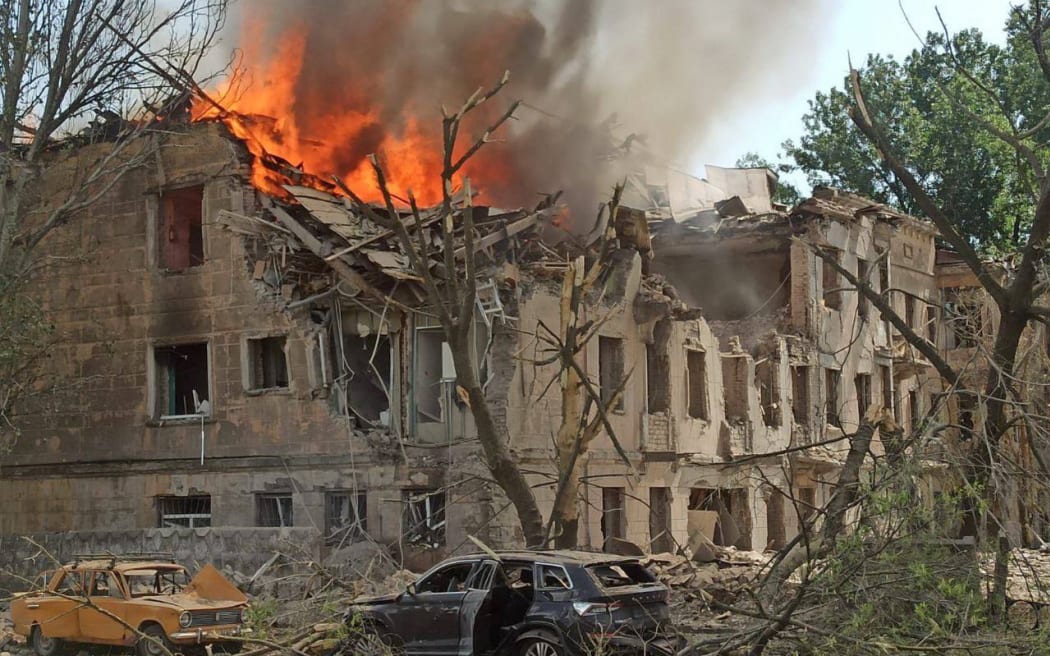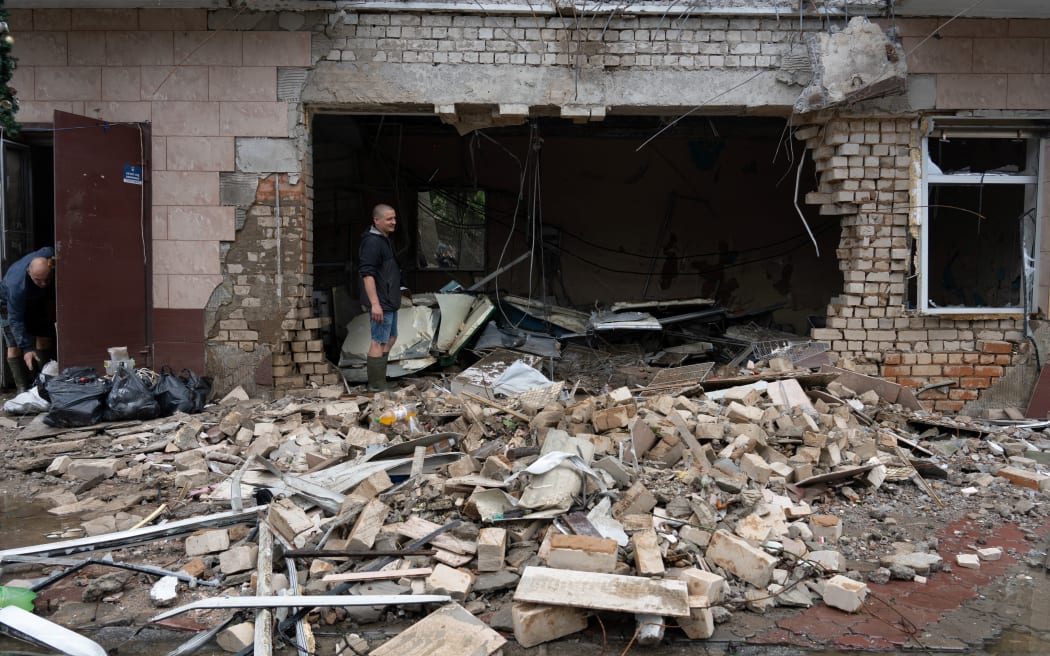Ukraine War: Frontline Forces Discuss Counterattack

The conflict has been going on for nearly 18 months.
photograph: Sergei Shestak/AFP
Andrew Harding writes for BBC News in eastern Ukraine
As the anesthesia began to wear off, a gaunt, muddy 19-year-old Ukrainian soldier let out a deep shriek in the backseat of an ambulance, fiddling with his oxygen mask and muttering: it’s my rifle ”
“They often do this. It’s a big trauma,” said Dr. Inna Dimitr, caressing the soldier’s pale face and knocking him unconscious as the ambulance veered off at breakneck speed and pulled away from the southeast Zaporizhzhya front line.
The young soldier’s name was Ole. It was quite possible that fragments of a Russian mortar that exploded in the trench that morning had cut a large hole in his hip and severed his spinal cord.
“He is in a stable but critical condition. There are a lot of patients like him,” said Dr Dimitr, pointing to six other cases in recent days. She works for the Western-funded private aid group MOAS.
As Ukrainian counter-attack casualties mount, a rare visit to this heavily guarded area of the Southern Front will allow some soldiers and observers to break through, or will the Russian defenses be okay? It’s easy to see why you’re starting to wonder. Buildings built and heavily fortified during the winter simply have too many barriers.
“Without more [Western] Please help me, I think we might lose this game,” said Kirillo, a Ukrainian marine whose left leg was ripped off by a Russian mine in 2020 but is now back on the front lines. Potras said. It turned out to be a big stumbling block.
“This Russian…there are a lot of them.” [of them]. They have a lot of anti-tank guns and missile systems,” he said.
Nevertheless, a month after this long-planned counterattack, there are many soldiers and experts who are vehemently opposed. The initial stage is progressing according to plan, and it is judged that the active front is drawing a rough arc and stretching long. The distance of more than 1,000 kilometers (620 miles) from the Black Sea coast to the Russian border in northeastern Ukraine will never be breached at the same rapid speed that Kiev’s forces achieved last year.

This handout photo released by the Telegram account of Serhiy Raisak, head of the Dnipropetrovsk Regional Military Administration on May 26, 2023 shows a missile attack on the city of Dnipropetrovsk in the midst of Russian military chaos. A fire at a medical facility, which is the site, is shown. Invasion of Ukraine.
photograph: Handout of Mr. Serhiy Raisak, Head of the Dnipropetrouks Regional Military Administration/Telegram Account/AFP
Having visited three separate sections of the front lines over the last few weeks and spoken to a variety of people, I like to divide these different perspectives into three large groups. Some see the Russian defense line as if it were made of tin, some see it as wood, others see it as glass.
The malleable yet resilient tin theory was first conceived to me more than two weeks ago by a weary doctor I met in a field hospital near the nearly destroyed Donbass town of Bakhmut.
Amid a clash and boom in artillery fire, he explained the rising number of Ukrainian casualties and warned that Russia was taking too long to prepare its defenses and had too many troops, and that Ukraine could pull back its front lines. We concluded that we could, but perhaps even dozens of people could retreat. Over several kilometers, it would be difficult to do more than weaken Russia’s overall strategic hold in eastern and southeastern Ukraine.
“I don’t think this war will be resolved on the battlefield. It will end in a political deal,” he said gloomily.
What reminded me of the theory of trees – which means that the front is likely to break or tear, but not collapse – is Velika, about a three-hour drive southwest of Bakmut. We had just crossed a small town called Novosirka.
In the open fields and rolling hills stretching towards the Black Sea, Ukrainian forces advanced, found a way to break through minefields, attacked Russian positions from unexpected angles, and slowly but steadily took up a significant portion of their territory. and occupied several villages and small towns. .
“I am a realist, but some people call me a pessimist,” said Artyom, a 36-year-old soldier, as Ukrainian fighter jets roared above. His view was that morale in the Russian army was low and that Ukraine was likely to make some significant progress in the coming months. However, the counterattack did not appear to turn into a rout, as happened briefly last November.
“The media and society are in a hurry. [But] The worst option is always possible,” he added, wondering what “price” Ukraine is willing to pay given the expected casualties from a strategic breakthrough of the Russian front. questioned.
It is worth noting that bleak views of the Ukrainian counterattack tend to emanate from the soldiers closest to the front lines and most involved in combat operations.
I would say they have the most experience and the most realistic views. But it’s also reasonable to point out that these soldiers are so focused on a small part of a larger military campaign that they barely get to see the big picture.

Locals clear debris from shops destroyed by Russian artillery fire in Kherson on June 12, 2023, as the area deals with massive flooding from the destruction of the Kakhovka hydroelectric dam.
photograph: Oleksi Filippov/AFP
So I come to the glass theory. A view widely held by eminent Western military analysts such as Mick Ryan and generals such as British commander Sir Tony Rudderkin, the counteroffensive is well underway and will likely take place in the coming weeks or months. Russia’s defense will be completed by then. It will be shattered, allowing Ukraine to seize strategically important territories and advance near (if not into) Crimea.
Proponents of this theory argue that the lack of Ukrainian air power will prevent the critical initial task of destroying Russia’s “operational system” (meaning logistical supply lines and command centers) from being carried out with the desired speed. It claims to mean it, and calls for patience rather than pessimism.
Instead, Ukrainian forces will use ground-based missiles to carry out their missions, while simultaneously attacking Russian positions in as many locations as possible to tie up and destroy as much enemy manpower and equipment as possible. are doing.
Britain’s chief of defense, Lord Tony, described the strategy in parliament this week as ‘starve, stretch and attack’, concluding that Russia has already ‘lost nearly half of its military’s combat potential’.
In another field hospital, a 19-year-old soldier with a serious back injury was briefly treated by doctors before heading to Zaporizhia in an ambulance. I asked. I summed up what I can still describe as the prevailing optimistic mood of most Ukrainian soldiers and officials I met here.
“Everyone is waiting [the breakthrough]. We believe and wait. we know everything will be fine. We just have to be patient,” he says with a smile as he sits in the sunshine outside a tidy field hospital as artillery fire echoes in the distance.
-BBC
https://www.rnz.co.nz/news/world/493357/ukraine-war-front-line-troops-discuss-counter-offensive Ukraine War: Frontline Forces Discuss Counterattack
